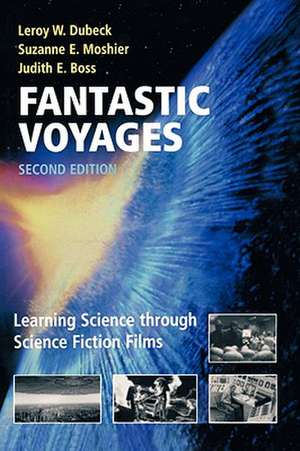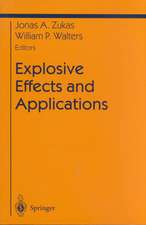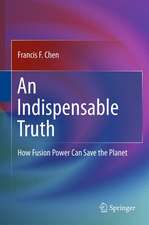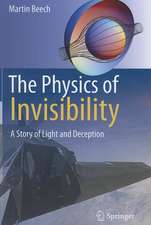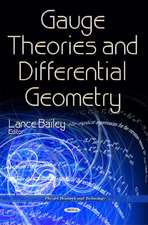Fantastic Voyages: Learning Science Through Science Fiction Films
Autor Leroy W. Dubeck, Suzanne E. Moshier, Judith E. Bossen Limba Engleză Paperback – 7 noi 2003
Preț: 359.39 lei
Nou
Puncte Express: 539
Preț estimativ în valută:
68.78€ • 71.05$ • 57.24£
68.78€ • 71.05$ • 57.24£
Carte disponibilă
Livrare economică 04-18 martie
Preluare comenzi: 021 569.72.76
Specificații
ISBN-13: 9780387004402
ISBN-10: 0387004408
Pagini: 347
Ilustrații: XVI, 348 p.
Dimensiuni: 156 x 234 x 18 mm
Greutate: 0.52 kg
Ediția:2nd ed. 2004
Editura: Springer
Colecția Springer
Locul publicării:New York, NY, United States
ISBN-10: 0387004408
Pagini: 347
Ilustrații: XVI, 348 p.
Dimensiuni: 156 x 234 x 18 mm
Greutate: 0.52 kg
Ediția:2nd ed. 2004
Editura: Springer
Colecția Springer
Locul publicării:New York, NY, United States
Public țintă
Popular/generalDescriere
What principle of mechanics is illustrated in the science fiction thriller Terminator 2: Judgment Day? How is nuclear fission important to the plot of Aliens? Is the time travel portrayed in Star Trek IV: The Voyage Home a real possibility? Discover the surprising answers to these and a host of other intriguing questions in Fantastic Voyages.
This book provides basic physics and biology instruction using scenes from popular science fiction films as examples of the concepts discussed. Scenes are discussed from such sci-fi classics as The Day the Earth Stood Still, Planet of the Apes and The Andromeda Strain. The latter includes study questions on biological terrorism. More recent hit films discussed include Contact, Jurassic Park and Independence Day.
The book is divided into three sections:
basic physics and astronomy for non-science majors
selected topics in biology
detailed plot descriptions of 42 films
The new edition also contains material about the greenhouse effect, nuclear power and nuclear terrorism, and the effects of an impact from a comet or asteroid.
Acclaim for the previous edition:
"If you find science fiction films thought-provoking, this could be the book for you...The scope of the book is wide, with a good grounding in basic physics and biology, and a lot of other information besides."
–New Scientist
"The idea of using science fiction films to convey science in an interesting way is sound, and anyone preparing a course using the genre should at least consult this book."
–Nature
ABOUT THE AUTHORS
Leroy W. Dubeck is Professor of Physics at Temple University, Philadelphia, Pennsylvania.
Suzanne E. Moshier is Professor of Biology at the University of Nebraska, Omaha.
Judith E. Boss is Professor of English at the University of Nebraska, Omaha.
This book provides basic physics and biology instruction using scenes from popular science fiction films as examples of the concepts discussed. Scenes are discussed from such sci-fi classics as The Day the Earth Stood Still, Planet of the Apes and The Andromeda Strain. The latter includes study questions on biological terrorism. More recent hit films discussed include Contact, Jurassic Park and Independence Day.
The book is divided into three sections:
basic physics and astronomy for non-science majors
selected topics in biology
detailed plot descriptions of 42 films
The new edition also contains material about the greenhouse effect, nuclear power and nuclear terrorism, and the effects of an impact from a comet or asteroid.
Acclaim for the previous edition:
"If you find science fiction films thought-provoking, this could be the book for you...The scope of the book is wide, with a good grounding in basic physics and biology, and a lot of other information besides."
–New Scientist
"The idea of using science fiction films to convey science in an interesting way is sound, and anyone preparing a course using the genre should at least consult this book."
–Nature
ABOUT THE AUTHORS
Leroy W. Dubeck is Professor of Physics at Temple University, Philadelphia, Pennsylvania.
Suzanne E. Moshier is Professor of Biology at the University of Nebraska, Omaha.
Judith E. Boss is Professor of English at the University of Nebraska, Omaha.
Cuprins
Physics 1. Science. 2. Mechanics. 3. Astronomy. 4. Electricity & Magnetism. 5. Atomic & Nuclear Physics. 6. Relativity & Time. 7. States of Matter. 8 Heat, Temperature, Thermodynamics. 9. Wave Motion & Sound. Biology 10. Global Warming & The Greenhouse Effect 11. Characteristics of Living Things. 12. Cellular Reproduction. 13. The Energy Needs of Living Things. 14. Plants and Animals Compared. 15. Multicellularity & Immunity. 16 Evolution. Film Descriptions '2001: A Space Odyssey' '2010: The Year We Make Contact' 'The Andromeda Strain' 'Blade Runner' 'Colossus: The Forbin Project' ' 'The day of the Trifids' ' 'The Day the Earth Caught Fire' 'The Day the Earth Stood Still' 'Fantastic Voyage' 'Forbidden Planet' 'Hangar 18' ' Them!' 'The Thing' 'The Time Machine' 'Total Recall' and others
Recenzii
From the reviews:
"If you find science fiction films thought-provoking, this could be the book for you ... The scope of the book is wide, with a good grounding in basic physics and biology, and a lot of other information besides." New Scientist
"The idea of using science fiction films to convey science in an interesting way is sound, and anyone preparing a course using the genre should at least consult this book." Nature
From the reviews of the second edition:
"Dubeck (Temple Univ.) and Moshier and Boss (both, Univ. of Nebraska at Omaha) in their new edition … try to provide basic physics and biology instruction using numerous science fiction films as examples. … With 116 pages treating films and literary commentary, excellent diagrams and pictures, and very good writing, this work accomplishes what it sets out to do as well as any small book can. Summing Up: Recommended. General readers; lower-and upper-division undergraduates." (P. R. Douville, CHOICE, June, 2004)
"If you find science fiction films thought-provoking, this could be the book for you ... The scope of the book is wide, with a good grounding in basic physics and biology, and a lot of other information besides." New Scientist
"The idea of using science fiction films to convey science in an interesting way is sound, and anyone preparing a course using the genre should at least consult this book." Nature
From the reviews of the second edition:
"Dubeck (Temple Univ.) and Moshier and Boss (both, Univ. of Nebraska at Omaha) in their new edition … try to provide basic physics and biology instruction using numerous science fiction films as examples. … With 116 pages treating films and literary commentary, excellent diagrams and pictures, and very good writing, this work accomplishes what it sets out to do as well as any small book can. Summing Up: Recommended. General readers; lower-and upper-division undergraduates." (P. R. Douville, CHOICE, June, 2004)
Textul de pe ultima copertă
What principle of mechanics is illustrated in the science fiction thriller Terminator 2: Judgment Day? How is nuclear fission important to the plot of Aliens? Is the time travel portrayed in Star Trek IV: The Voyage Home a real possibility? Discover the surprising answers to these and a host of other intriguing questions in Fantastic Voyages.
This book provides basic physics and biology instruction using scenes from popular science fiction films as examples of the concepts discussed. Scenes are discussed from such sci-fi classics as The Day the Earth Stood Still, Planet of the Apes and The Andromeda Strain. The latter includes study questions on biological terrorism. More recent hit films discussed include Contact, Jurassic Park and Independence Day.
The book is divided into three sections:
basic physics and astronomy for non-science majors
selected topics in biology
detailed plot descriptions of 42 films
The new edition also contains material about the greenhouse effect, nuclear power and nuclear terrorism, and the effects of an impact from a comet or asteroid.
Acclaim for the previous edition:
"If you find science fiction films thought-provoking, this could be the book for you...The scope of the book is wide, with a good grounding in basic physics and biology, and a lot of other information besides."
–New Scientist
"The idea of using science fiction films to convey science in an interesting way is sound, and anyone preparing a course using the genre should at least consult this book."
–Nature
ABOUT THE AUTHORS
Leroy W. Dubeck is Professor of Physics at Temple University, Philadelphia, Pennsylvania.
Suzanne E. Moshier is Professor of Biology at the University of Nebraska, Omaha.
Judith E. Boss is Professor of English at the University of Nebraska, Omaha.
This book provides basic physics and biology instruction using scenes from popular science fiction films as examples of the concepts discussed. Scenes are discussed from such sci-fi classics as The Day the Earth Stood Still, Planet of the Apes and The Andromeda Strain. The latter includes study questions on biological terrorism. More recent hit films discussed include Contact, Jurassic Park and Independence Day.
The book is divided into three sections:
basic physics and astronomy for non-science majors
selected topics in biology
detailed plot descriptions of 42 films
The new edition also contains material about the greenhouse effect, nuclear power and nuclear terrorism, and the effects of an impact from a comet or asteroid.
Acclaim for the previous edition:
"If you find science fiction films thought-provoking, this could be the book for you...The scope of the book is wide, with a good grounding in basic physics and biology, and a lot of other information besides."
–New Scientist
"The idea of using science fiction films to convey science in an interesting way is sound, and anyone preparing a course using the genre should at least consult this book."
–Nature
ABOUT THE AUTHORS
Leroy W. Dubeck is Professor of Physics at Temple University, Philadelphia, Pennsylvania.
Suzanne E. Moshier is Professor of Biology at the University of Nebraska, Omaha.
Judith E. Boss is Professor of English at the University of Nebraska, Omaha.
